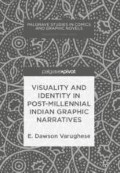Abstract
This chapter explores representations of Indian identities in post-millennial Indian graphic narratives through their depiction of loyalty and allegiance to a nation, caste and celebrity stardom set to a backdrop of New India. In analysing one graphic short story (Twelve: How it ends), one creative, graphic non-fiction work published by Navayana (Bhimayana), one graphic novel (Kashmir Pending) and one graphic novella by Appupen (Legends of Halahala), this chapter considers the visual language of contested Indian identities and looks at how these various identities are problematised, presented and embodied in the text-image interface of the four modes of graphic representation detailed here.
Access this chapter
Tax calculation will be finalised at checkout
Purchases are for personal use only
Notes
- 1.
See Medhurst and Desousa on the idea of the ‘graphic voice’ (1981, 227).
- 2.
kahani is a Urdu, rather than Sanskrit, lexeme.
- 3.
Jangarh exhibited in cities in India, in Paris, at the Pompidou Centre and in Japan. It was reported that he was treated unfairly in Japan whilst on a residency—his paintings fetched a handsome price, of which he saw little—and with his passport kept by the authorities, Jangarh became depressed. He committed suicide in 2001; he was not even 40 years old.
- 4.
Further conflation might occur because Dalits are referred to as members of a Scheduled Caste and tribal peoples such as the Gond people are referred to as members of Scheduled Tribes (the word ‘schedule’ follows the Constitution of India which lists 12 Schedules).
- 5.
See Tripathi (2016): http://www.thehindu.com/features/metroplus/roshni-vyam-on-gond-art/article8590227.ece#! (accessed May 2017).
- 6.
Connections might be made here to what Groensteen says about the layout of manga. He writes: ‘The type of manga that features the most unusual layouts, those that diverge the most emphatically from Western conventions, is without doubt shōjo manga, that is to say manga for teenage girls (normally drawn by women)’ (Groensteen 2013, 57).
- 7.
I use ‘security forces’ here to mean either armed forces, police, ‘law keepers’ or a combination, as it is often unclear in the graphic novel which ‘type’ of security force is present (although all are mentioned).
- 8.
Appupen’s portfolio of work to date is at times redolent of abstract sequential art following Kym Tabulo (2014, 30) especially in the repeated designs found on the front covers (see Moonward as example) and in the ‘white-spaces’ I mention here.
- 9.
Appupen is the pen name of George Mathen, a name which strongly suggests a Christian Keralite heritage.
- 10.
See Dawson Varughese (2017), “(Social) Memory, Movements and Messaging on Tulsi Pipe Road: ‘seeing’ public wall art in Mumbai,” South Asia.
- 11.
Lord Shiva closes his eyes in order not to observe; he refuses the invitation to observe the world and is thus self-contained in his indifference to the world.
- 12.
These boards are reminiscent of advertising schemes in cities like Mumbai, whereby enormous boards display celebrities endorsing everything from apartments to watches to clothes. Mumbai is particularly renowned for this visual experience. New Delhi, for example, does not have the same approach to advertising (with the inclusion of Bollywood celebrities).
References
Ahmed, Naseer, and Saurabh Singh. 2007. Kashmir Pending. New Delhi: Phantomville.
Appupen. 2013. Legends of Halahala. Noida: HarperCollins Publishers India.
Baetens, Jan, and Hugo Frey. 2015. The Graphic Novel: An Introduction. Cambridge: Cambridge University Press.
Chatterji, Roma. 2012. Speaking with Pictures: Folk Art and the Narrative Tradition in India. New Delhi: Routledge.
Cohn, Neil. 2014. The Visual Language of Comics: Introduction to the Structure and Cognition of Sequential Images. London: Bloomsbury.
Dawson Varughese, E. 2017. (Social) Memory, Movements and Messaging on Tulsi Pipe Road: “Seeing” Public Wall Art in Mumbai. South Asia November (online).
Duncan, Randy. 2012. Images Functions: Shape and Color as Hermeneutic Images in Asterios Polyp. In Critical Approaches to Comics, ed. Matthew J. Smith and Randy Duncan, 43–54. New York/London: Routledge.
Groensteen, Thierry. 2013. Comics and Narration. Jackson: The University Press of Mississippi.
Guru, Gopal. 2016. For Dalit History Is Not Past but Present. In Words Matter: Writings Against Silence, ed. K. Satchidanandan. New Delhi: Penguin, Viking.
Kramrisch, Stella. 1992. The Presence of Śiva. Princeton: Princeton University Press.
Medhurst, Martin J., and Michael A. Desousa. 1981. Political Cartoons as Rhetorical Form: A Taxonomy of Graphic Discourse. Communication Monographs 48 (3): 197–236.
Oza, Vasvi. 2011. Questions of Reading and Readership of Pictorial Texts: The Case of Bhimayana, a Pictorial Biography of Dr. Ambedkarm. Journal of Writing in Creative Practice 4 (3): 351–365.
Pinto, J. 2004. Thinking Out of the Box. Biblio (July/August). http://www.biblio-india.org
Round, Julia. 2007. Visual Perspective and Narrative Voice in Comics: Redefining Literary Terminology. International Journal of Comic Art 9 (2): 316–329.
Smith, Sidonie. 2011. Human Rights and Comics: Autobiographical Avatars, Crisis Witnessing, and Transnational Rescue Networks. In Graphic Subjects: Critical Essays on Autobiography and Graphic Novels, ed. Michael A. Chaney, 61–72. Wisconsin: University of Wisconsin.
Tabulo, Kym. 2014. Abstract Sequential Art. Journal of Graphic Novels and Comics 5 (1): 29–41.
Thomas, Pratheek, and Aindri Chakraborty. 2013. Twelve: How It Ends. Bangalore: Manta Ray.
Tripathi, Shailaja. 2016, May 12. http://www.thehindu.com/features/metroplus/roshni-vyamon-gond-art/article8590227.ece#!. Accessed May 2017.
Vyam, Durgabai, Subhash Vyam, Srividya Natarajan, and S. Anand. 2012. Bhimayana: Experiences of Untouchability. New Delhi: Navayana Publishing.
Author information
Authors and Affiliations
Rights and permissions
Copyright information
© 2018 The Author(s)
About this chapter
Cite this chapter
Varughese, E.D. (2018). Identity: Representations of ‘Indianness’. In: Visuality and Identity in Post-millennial Indian Graphic Narratives. Palgrave Studies in Comics and Graphic Novels. Palgrave Macmillan, Cham. https://doi.org/10.1007/978-3-319-69490-0_4
Download citation
DOI: https://doi.org/10.1007/978-3-319-69490-0_4
Published:
Publisher Name: Palgrave Macmillan, Cham
Print ISBN: 978-3-319-69489-4
Online ISBN: 978-3-319-69490-0
eBook Packages: Literature, Cultural and Media StudiesLiterature, Cultural and Media Studies (R0)

